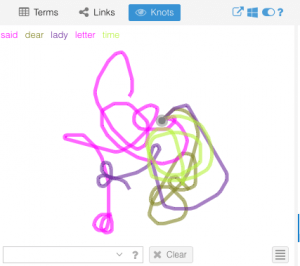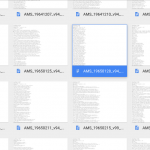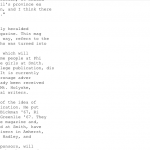People say a picture is worth a thousand words. Well, thanks to the “Knots” tool on Voyant, I have an apt visualization of my research process this summer:
To be honest, I came into the internship fully expecting this type of noodling, more professionally known as “exploration.” After all, our buzzword for the first part of the internship (when we were still learning about digital tools and how to define the digital humanities) was “nebulous.” Unlike the other projects, mine has remained abstract until the last possible minute, although upon reflection, the direction it finally took makes logical sense based on the ideas I have been hovering around all summer.
The most challenging part of my project was defining what it would be. Here’s an attempt at tracing how my interests morphed into the final product:
Week 1-3
Interests: origins of publications (mission statements, how and why they came to be, the people involved) – the human connection
Problems: too vague; some publications wrote a lot about their mission statement but others didn’t have any; must narrow down or else too many publications to deal with
Week 4
Interests: Literary magazines (Why? Because it is a challenge- I had no idea how to begin applying digital tools to study them)
Problems: less vague BUT huge issues regarding tools – what kind of digital tools can do justice to creative works? Also, still a lot of data to ingest. Must narrow down either by time period or by specific magazines.
Week 5
Interests: narrowed down among the literary magazines to five experimental magazines (experimental magazines suit my needs because there are few of them and most are short-lasting → less pages to deal with)
Problems: I don’t get these magazines. It is very difficult to trek through these pieces because they elicit reactions ranging from “Oh cool!” to “I don’t think this author is from Earth.” If a human reader cannot begin to wrap her mind around these odd beings, how can digital tools help?
Week 6
Interests: Narrowed down again to two experimental magazines, Adelphian and Io.
Possible headway:
1) a mapping project with Adelphian: their mission statement was about recruiting voices not attracted to more conventional magazines. I planned to collect all the places, locations, and ethnicities mentioned in each piece and compare them with those found in the Amherst Literary Magazine (the more “established” and conventional rival).
2) Run textual analysis over the OCR of the text and see what patterns emerge. OCR stands for Optical Character Recognition- it basically converts printed texts in pdfs into editable formats such as Word. Voyant has a range of tools I can explore, but I would need to generate my own OCR.
Problems:
The process of creating OCR to put into Voyant takes too long. I would have to take pictures of all the pages I need, convert them into PDFs, and then do some magic to convert them to OCR. But the toughest part is the data cleanup: OCR conversion is not perfect, so it misspells words, which I would have to correct if I want Voyant to yield any useful data. That didn’t sound too bad on paper, until I was confronted with this:

Although it is an almost mindless task to go through and correct these spellings, it just takes me too long. I had to weigh the time required with the results that this could have yielded. This is when an extra few weeks of play time would have been awesome. My biggest regret is not knowing what kind of data and insight textual analysis and topic modeling could have produced; if only I had a Time-Turner… and more technical ability.
Tried mapping with a tool in Voyant called RezoViz. RezoViz picks up names of places and locations in the text and visualize their relationships. When I ran a small sample of OCR, it loaded infinitely, at least until I pressed cancel. I was very confused, as the tool had worked reliably in other projects. A day later, I realized that I was the silly one: because I input the OCR text of the entire magazine, I was essentially asking the tool to draw relationships between characters and places across different pieces, which was impossible.
Week 7-8: The Work Waits
After realizing that I could not make headway with the plans I had in mind for Adelphian, I turned to my back-up: Io. The aspects that drew me to Io in the first place were its premise (coherency over individual brilliance) and its rebellion against the conventional literary magazines. It also helped that its editor, Richard Grossinger, wrote passionately about it in a five-page printout in a small folder called “History of Io.” Although I doubt there are any humans or tools that could penetrate the layers of meaning within the four issues of Io that the Archives has, what I could do was to find a way to illuminate the history of this peculiar magazine, giving something of the human to these two inconspicuous folders tucked away in Box 10.
In order to do this, I turned to a digital exhibit, because it would allow me to provide the context of Io‘s history by combining text and images in an interactive way. The images would come from any articles that I find in the Amherst Student- clues to Io‘s reception. Because Io-1 is in public domain, I was also able to include some images of what the inside of an issue looks like, because I think its mission statement directly informed its appearance and layout.
Once I can visualize what my project would focus on and look like, the hard part is over. Yes, the actual work of assembling all of the articles I collected into something coherent and writing about them (ah the lovely and revolting writing process!) took up the rest of the nine days that I have before the day of the presentation.
[Side note: my favorite discovery was stumbling upon a letter from President Calvin Plimpton folded into Io-3 (it’s still there, between pg 11 and 12!) while I was “reading” through all four issues. It was a treat to get my hand on the actual document and not just, for example, read about it in a newspaper article.]
I’ll keep the actual process short and sweet (if you were only interested in this, I apologize for the all the words above):
- scan through the OCR of the Amherst Student, using keywords such as Grossinger, Phi Psi, and literary magazines; I have never been so thankful for the Command + F function, which searches through all of the text for the keyword. Unfortunately, it doesn’t work for the files concatenating all of the issues produced in a school year, so I had to go through every single issues between 1963 and 1973 to make sure I did not miss anything crucial.
- Using this information, I located the relevant newspaper pdfs on the library server and crop out all of the articles I needed.
- I also combed through the Olio, but was unable to find much relevant information. Perhaps because of the turmoil surrounding Phi Psi’s secession, the Olio was uncertain as to whether to include it in the fraternity section, or at all.
- Learned how to use wordpress; created the information architecture for my section of the website- determining how many pages to use, which images go where, and how much to write.

A page from my info architecture Because I did not want this to be an online essay, I limited myself to a small number of short paragraphs per page, interspersed with images and other tidbits to break the paragraph monotony. To solve the length issue, I added hyperlinks for certain groups and names (ex. Robert Kelly and Phi Psi), giving the user the option to learn more if he/she wishes. This prevented my main pages from being cluttered with too much text.
- The model I used was the Richard Pryor website, which accompanied a biography.
- Once organization was done, the writing commenced. Pictures needed to have metadata as well.
- The last two days involved meticulous adjustments on wordpress so everything appeared the way I wanted.
Conclusion:
At first glance, my research process has generally been a funnel, a constant narrowing of focus to make sure the amount of material that I work with is within a certain tool’s limits, and those of my own, in a timeframe of a few weeks. But the narrowing of focus liberated my research, because I could choose depth over breadth. For the tricky goal that was examining literary magazines, focusing on the origins, reception, impact, and legacy of just one magazine has allowed me to ground my initial interests in the people behind the pages – the human connection – with historical context. Io was born out of serendipity combined with a desire to react against the stifling conventions of its time. With this hybrid of a digital exhibit, I hope to provide a glimpse of Amherst in the late 1960s through the lens of this little experimental magazine.



